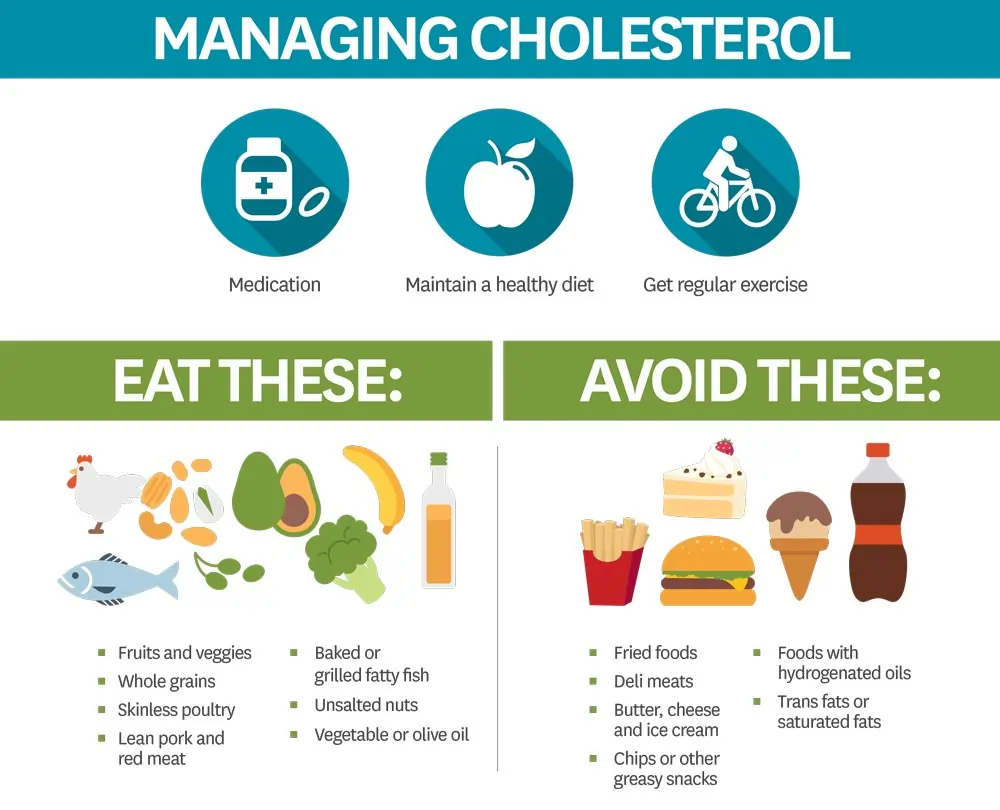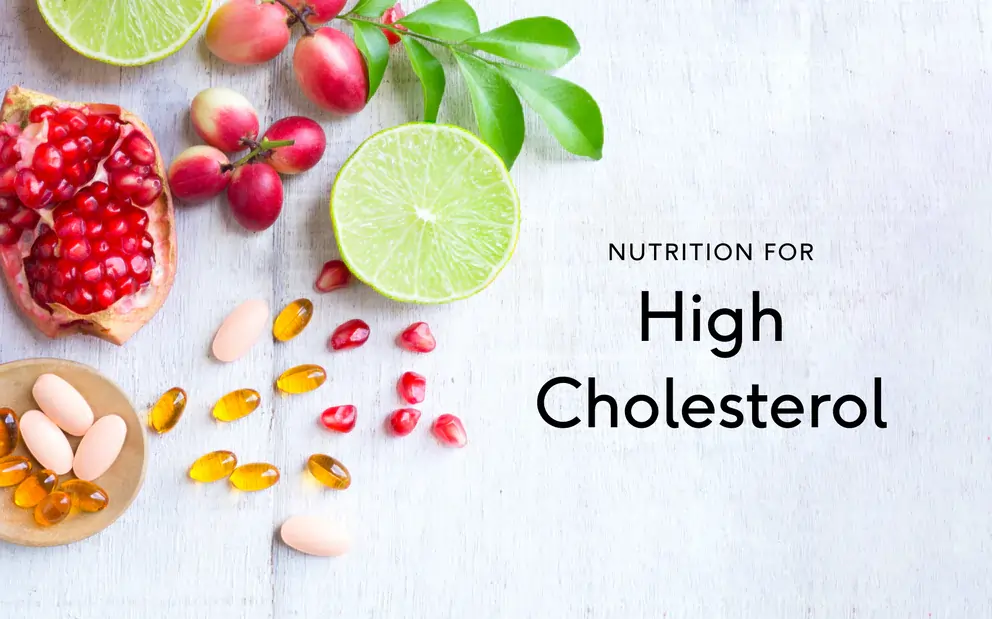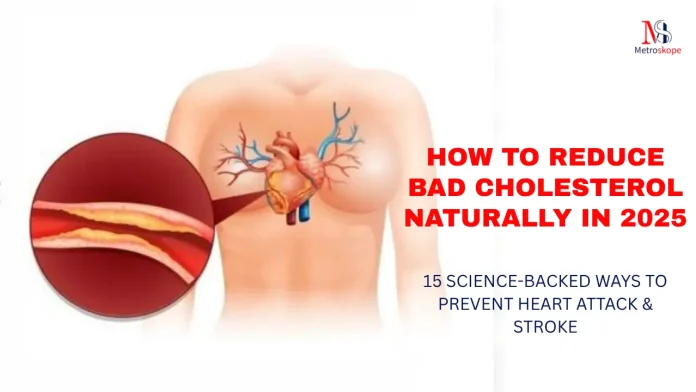How to Reduce Bad Cholesterol Naturally in 2025: Heart disease and stroke remain the top two killers worldwide, and the common thread behind both is elevated low-density lipoprotein (LDL) cholesterol—often labeled “bad cholesterol.”
When too much LDL circulates in your blood, it sticks to artery walls, forming plaques that can rupture and block blood flow to the heart or brain.
The good news: modern research shows you can lower LDL cholesterol naturally—often by 10-30%—through targeted lifestyle changes, smart nutrition, and evidence-based supplements.
the latest science (2025) into 15 actionable steps that will help you protect your heart for decades to come.
1. Slash Saturated Fats—But Don’t Fear All Fat
Saturated fats raise LDL by signaling the liver to pump out more cholesterol-rich lipoproteins. Limit:
- Fatty cuts of red meat (rib-eye, pork belly)
- High-fat dairy (whole milk, cheese, cream)
- Coconut and palm oils in packaged snacks
Swap in monounsaturated fats (olive oil, avocados, almonds) and omega-3-rich polyunsaturated fats (salmon, walnuts). These healthier fats can lower LDL and boost protective HDL.
2. Delete Trans Fats Completely

Artificial trans fats (“partially hydrogenated oils”) are cholesterol bombs—they raise LDL and drop HDL.
The WHO’s 2023 global ban removed most industrial trans fats, but they still lurk in some imported baked goods, microwave popcorn, and non-dairy creamers. Check labels; aim for zero grams.
3. Embrace Soluble Fiber—5–10 g Daily
Soluble fiber binds bile acids in the gut, forcing the liver to pull LDL from the bloodstream to make more bile. Just 5–10 g a day can cut LDL by up to 10%.
Top picks (grams soluble fiber per serving):
- Oats, oat bran – 3 g per ¾ cup cooked
- Barley – 2 g per ½ cup cooked
- Black beans – 2 g per ½ cup
- Apples, citrus, carrots – 1–2 g each
Pro tip: Start breakfast with oatmeal plus chia seeds to lock in 4–5 g before noon.
4. Power Up with Plant Sterols & Stanols
Naturally occurring plant compounds resemble cholesterol, so they compete for absorption and lower LDL 7–12% in as little as three weeks.
Sources:
- Fortified yogurts, margarines, or orange juice (look for “1 g plant sterols per serving”)
- Pistachios, sesame seeds, sunflower seeds (smaller amounts)
Target 2 g a day, typically two servings of a fortified food.
5. Go Fish Twice a Week—or Supplement Omega-3s
EPA and DHA omega-3s don’t slash LDL dramatically, but they:
- Lower triglycerides 20–30%
- Reduce plaque inflammation
- Stabilize heart rhythm
Aim for two 120 g servings of fatty fish (salmon, mackerel, sardines) weekly. If you’re vegan or fish-averse, choose an algae-based DHA/EPA supplement (1,000 mg daily).
6. Lift and Move: 150 Minutes of Cardio + 2 Strength Sessions
Aerobic activity increases LDL receptors on liver cells, clearing cholesterol faster, while resistance training raises HDL. The American Heart Association’s 2025 guideline:
- 150–180 minutes moderate cardio (brisk walking, cycling) or 75 minutes vigorous (running, HIIT) weekly
- 2 muscle-strengthening sessions covering all major groups
Every additional 30 minutes of weekly exercise translates into roughly a 1 mg/dL LDL drop and a 1 mg/dL HDL rise.
7. Maintain a Healthy Weight (BMI 18.5–24.9)
Each 5% drop in body weight can shave 5 mg/dL off LDL while boosting HDL. Combine calorie-aware eating with movement: cut 500 kcal/day to lose about 0.5 kg weekly.
8. Choose Whole Grains Over Refined
Refining strips the bran (fiber) and germ (nutrients) from grains, spiking blood sugar and triglycerides. Select:
- Brown rice, quinoa, and bulgur over white rice
- 100% whole-wheat bread over white
- Steel-cut oats over instant oats
Aim for three 30 g servings daily.
9. Load Up on Antioxidant-Rich Produce
Oxidized LDL is the real artery-clogging villain. Colorful fruits and veggies provide antioxidants that neutralize free radicals.
Shoot for 5–7 cups of produce daily with a “rainbow plate” philosophy: berries (blue), spinach (green), sweet potato (orange), beets (red), eggplant (purple).
10. Quit Smoking—See HDL Rise in Weeks
Cigarette toxins damage arterial walls and drop HDL by 5–10%.
Within three months of quitting, HDL rebounds, and within a year, heart-attack risk falls by 50%. Get help via nicotine-replacement therapy, prescription meds, and support groups.
11. Moderate Alcohol—Or Skip It
Up to one drink daily for women, two for men may raise HDL slightly, but excess alcohol elevates triglycerides, blood pressure, and stroke risk. If you don’t drink, don’t start. If you do, keep it moderate:
- 150 ml wine
- 350 ml beer
- 45 ml 40% spirits
12. De-Stress with Mindfulness and Sleep Hygiene
Chronic stress releases cortisol and adrenaline, pushing the liver to crank out more VLDL (very-low-density lipoprotein) that converts into LDL.
Action plan:
- 10 minutes daily of guided meditation or box breathing
- 7–9 hours of sleep (use blue-light filters after 9 PM)
- Nature walks or yoga twice weekly
13. Spice It Up with Garlic & Turmeric
Meta-analyses show aged garlic extract can reduce LDL by 5–8% over three months, while curcumin in turmeric improves HDL and lowers oxidized LDL. Use fresh garlic in cooking; consider standardized supplements (consult your doctor).
14. Add Whey or Soy Protein

Replacing refined carbs with 25 g/day of soy protein can drop LDL up to 6%. Whey isolate (20 g post-workout) promotes muscle repair and modest LDL reductions.
Try a smoothie: unsweetened soy milk, whey powder, spinach, berries, and flaxseed.
15. Schedule Regular Lipid Panels and Know Your Numbers
Adults 20+ should check cholesterol every 4–6 years, or more often if at risk. Ideal targets (2025):
| Metric | Optimal Level |
|---|---|
| LDL-C | < 100 mg/dL (or <70 mg/dL for high-risk) |
| HDL-C | > 40 mg/dL (men), > 50 mg/dL (women) |
| Triglycerides | < 150 mg/dL |
| Total-C | < 200 mg/dL |
If lifestyle changes don’t hit targets in 3–6 months, discuss statins, ezetimibe, or PCSK9 inhibitors with your physician.
Sample One-Day Heart-Healthy Meal Plan
| Meal | Food | Why It Helps |
|---|---|---|
| Breakfast | 1 cup oatmeal + 1 tbsp chia + ½ cup blueberries | 5 g soluble fiber + antioxidants |
| Mid-morning | 10 almonds + 1 apple | Plant sterols, pectin |
| Lunch | Quinoa salad with chickpeas, spinach, tomatoes, olive-oil vinaigrette | Fiber, plant protein, MUFAs |
| Snack | Low-fat Greek yogurt + 1 tsp ground flaxseed | Whey protein, omega-3 ALA |
| Dinner | Grilled salmon, 1 cup steamed broccoli, ½ cup brown rice | Omega-3s, cruciferous antioxidants, whole grain fiber |
| Dessert | 25 g dark chocolate (70% cocoa) | Polyphenols boost HDL |
Daily totals: ~2,100 kcal, 30 g soluble fiber, 1.8 g plant sterols, 2 g omega-3s.
Frequently Asked Questions
Q 1: How fast can I lower LDL naturally?
Most people see measurable changes within 4–6 weeks after adopting multiple strategies, but significant drops (20–30%) usually take 3–6 months.
Q 2: Are eggs safe?
Current research finds that 1 whole egg/day is fine for most healthy adults; they raise HDL more than LDL. Pair with veggies and avoid butter/processed meats.
Q 3: Do I need supplements?
Not always. Diet and exercise work for many, but plant sterol spreads, soluble-fiber powders, or omega-3 capsules can add an extra 5–10% LDL reduction if diet alone stalls.
Key Takeaways
- Combine changes—food, fitness, weight control, and stress relief—for the biggest LDL drop.
- Target 5–10 g soluble fiber and 2 g plant sterols daily; eliminate trans fats entirely.
- Exercise 150+ minutes weekly; strength-train twice.
- Quit smoking, moderate alcohol, and prioritize sleep to boost HDL.
- Check lipids regularly and team up with a healthcare professional if goals aren’t met.
Implement these 15 science-backed habits consistently and you’ll not only lower LDL cholesterol naturally but also slash your lifetime risk of heart attack and stroke—without fad diets or extreme restrictions. Your heart will thank you.

